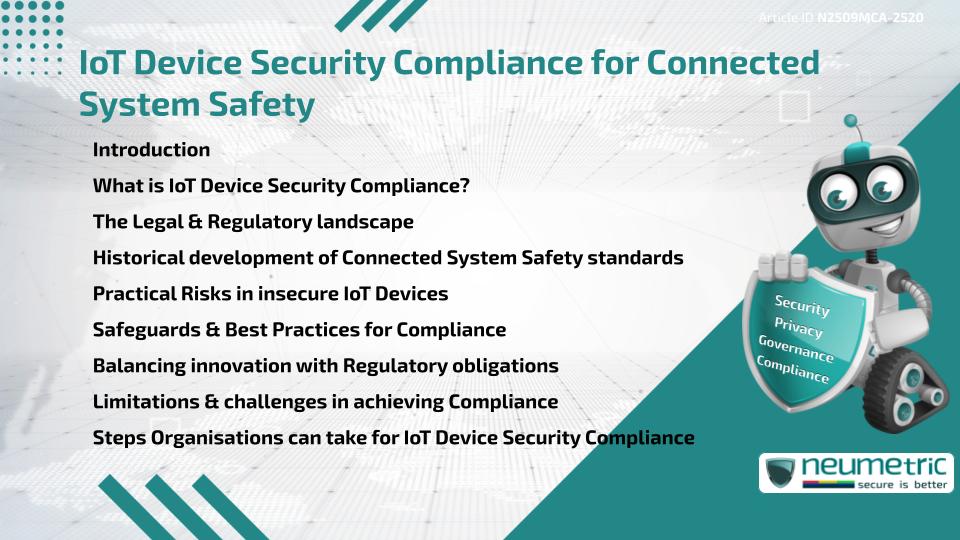Table of Contents
ToggleIntroduction
IoT Device Security Compliance is essential for ensuring the safety & reliability of Connected Systems. With billions of Smart Devices embedded in Homes, Healthcare, Transportation & Industry, weak security can expose users to Cyber Threats, Data Breaches & Operational disruptions. Compliance frameworks establish guidelines to protect Devices & Systems from Vulnerabilities. This article explores what IoT Device Security Compliance means, the legal landscape, historical development, Risks, safeguards, limitations & steps Businesses can take to achieve secure & compliant IoT Operations.
What is IoT Device Security Compliance?
IoT Device Security Compliance refers to meeting Regulatory, Technical & Industry requirements to ensure that IoT Devices operate safely within Connected Systems. It involves securing Hardware, Software & Communication Protocols to prevent unauthorised access & data manipulation. Compliance builds User Trust, ensures System Safety & supports Interoperability between Devices from different Vendors.
The Legal & Regulatory landscape
The Legal Framework for IoT Device Security Compliance varies across regions. For example, the European Union has introduced the Cybersecurity Act, which includes Certification schemes for connected Devices. In the United States, the IoT Cybersecurity Improvement Act sets baseline security standards for federal use of IoT Devices. Many industries also follow voluntary standards, such as ISO/IEC 27001, to address specific Risks.
Historical development of Connected System Safety standards
The need for IoT Device Security Compliance grew as IoT adoption expanded. Early Connected Systems often prioritised functionality over security, leading to large-scale Botnet Attacks such as Mirai. These Incidents demonstrated that insecure IoT Devices could disrupt entire networks. Over time, Regulators, Industry groups & Security Researchers developed guidelines & standards to embed security into IoT Design & Deployment.
Practical Risks in insecure IoT Devices
Insecure IoT Devices pose significant Risks, including:
- Unauthorised access to Sensitive Data
- Remote control of critical systems such as Medical Equipment or Vehicles
- Malware propagation through Large Networks
- Exploitation of weak default Passwords & outdated Firmware
- Disruption of Industrial processes & Supply Chains
These Risks highlight why IoT Device Security Compliance is both a Regulatory requirement & a practical necessity for Businesses & Governments.
Safeguards & Best Practices for Compliance
To achieve Compliance, Organisations must implement both Technical & Organisational safeguards. Common practices include:
- Strong Authentication & Access Controls
- Regular Software & Firmware updates
- Encryption of data in transit & at rest
- Security Testing & Vulnerability Assessments
- Clear Incident Response Plans
Balancing innovation with Regulatory obligations
IoT Technologies drive innovation in fields such as Healthcare, Smart Homes & Logistics. However, innovation can conflict with Compliance if Products are rushed to Market without adequate Security Testing. Businesses must strike a balance by embedding security into Product lifecycles, engaging with Regulators early & adopting standardised Frameworks. This balance ensures safety without stifling progress.
Limitations & challenges in achieving Compliance
Despite its importance, IoT Device Security Compliance faces limitations. Small & Medium Enterprises may lack Resources to implement robust Safeguards. Regulations differ across jurisdictions, creating complexity for global manufacturers. Moreover, Compliance frameworks may lag behind emerging Threats, leaving Devices vulnerable. These challenges underline the need for Continuous Improvement & Cooperation across Industries.
Steps Organisations can take for IoT Device Security Compliance
Organisations seeking effective Compliance should:
- Conduct regular Risk Assessments
- Implement secure-by-design principles in IoT development
- Establish Supply Chain Security checks
- Train Employees in IoT Security Awareness
- Monitor emerging Regulations & Update practices accordingly
By adopting these steps, Organisations can enhance resilience & maintain Trust in Connected Ecosystems.
Conclusion
IoT Device Security Compliance is critical to ensuring Connected System safety. It protects Users, strengthens Trust & enables sustainable Innovation. While challenges exist in aligning Regulations, managing Risks & ensuring Affordability, Organisations that embrace Compliance as an integral part of IoT development can safeguard both Operations & Customers.
Takeaways
- IoT Device Security Compliance ensures safety & trust in Connected Systems
- Regulations differ globally but share common goals of reducing Risks
- Historical incidents highlight the need for strong safeguards
- Risks include data theft, operational disruption & system manipulation
- Best Practices & secure-by-design approaches improve Compliance outcomes
FAQ
What does IoT Device Security Compliance mean?
It means following Laws, Standards & Best Practices to ensure IoT Devices operate safely & securely.
Why is IoT Device Security Compliance important?
It protects Users & Systems from Cyberattacks, Data Breaches & Disruptions.
What Regulations govern IoT Device Security?
Examples include the EU Cybersecurity Act & the US IoT Cybersecurity Improvement Act.
What are common Risks in insecure IoT Devices?
Risks include Unauthorised Access, Malware, Data Theft & System Disruptions.
How can Businesses achieve Compliance?
They can implement Encryption, Authentication, regular Updates & Incident Response Plans.
Do Small Businesses face difficulties with Compliance?
Yes, Resource constraints & Regulatory complexity often make Compliance harder for Smaller Firms.
How does Compliance affect Innovation?
Compliance ensures Products are secure without undermining Innovation, but requires Planning & Investment.
Need help for Security, Privacy, Governance & VAPT?
Neumetric provides organisations the necessary help to achieve their Cybersecurity, Compliance, Governance, Privacy, Certifications & Pentesting needs.
Organisations & Businesses, specifically those which provide SaaS & AI Solutions in the Fintech, BFSI & other regulated sectors, usually need a Cybersecurity Partner for meeting & maintaining the ongoing Security & Privacy needs & requirements of their Enterprise Clients & Privacy conscious Customers.
SOC 2, ISO 27001, ISO 42001, NIST, HIPAA, HECVAT, EU GDPR are some of the Frameworks that are served by Fusion – a SaaS, multimodular, multitenant, centralised, automated, Cybersecurity & Compliance Management system.
Neumetric also provides Expert Services for technical security which covers VAPT for Web Applications, APIs, iOS & Android Mobile Apps, Security Testing for AWS & other Cloud Environments & Cloud Infrastructure & other similar scopes.
Reach out to us by Email or filling out the Contact Form…


